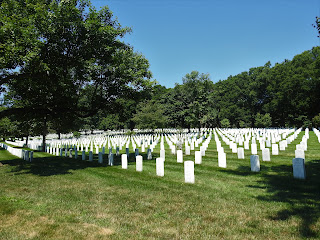 |
| My brothers and sisters (who attended) and us |
Well, we made it to the Kraus family reunion by Saturday
afternoon. A little late, yes, but not
bad for a 4,500 mile route from Pahrump through the deep South to DC to
Delavan, WI, hey? The Kraus family is
doing great, all things considered and we had a good time. The children have grown and I had to relearn names
and faces. The beauty of old age: you meet new people and get new relatives all
the time!
 |
| The whole Kraus crew (who attended) |
Our next destination is Eagle River, WI, 275 miles
directly north. When asked why, the
answer was easy: because we’ve never
been there. That’s how we do it… close
our eyes and point at the map. The route
was so pretty, through the green farmland covered at this time with wheat, tall
and tassled corn, beans and other crops.
The John Deeres and crop dusters were busily engaged in caring for the
nation’s breadbasket. Every now and
then, we would come upon a dairy with a big “cheese” sign out front. At last, unable to stand it, we jumped off
the highway to unload part of our bank account and fill the refer with many
pounds of different types of cheeses, sausage and locally-made candies.
 |
| Bloody Mary Wisconsin style |
 |
| Here we are in Wisconsin |
We left home hot and dry towards sweltering heat and
unbearable humidity. Now we are in northern
WI where it is 75F and 45F at night, requiring a comforter. Out with the sweat pants! What a relief!
Eagle River boasts its cranberry bogs. It is the perfect climate and soil to grow
this fruit which likes chilly weather and acidic, peaty sand, characteristics
of the land in this northern area. We
visited the Lake Nokonis Cranberries Co. bogs in Eagle River today and walked
out to where they grow. The bogs are
long, wide stretches of land and between each one are raised paths for
vehicles. The sand is leveled in the
spring by adding more sand and when new vines are planted, it takes 3-5 years
for them to produce berries. In June,
bees are rented from Arkansas and they pollinate the plants for about a
month. There are 2 hives per acre, 650
acres worth of bees. The berries are
green right now, but in the fall they turn red.
They take some samples to a lab to make sure the color and sugar content
are correct and then the harvest begins.
They partially flood the bogs and a big rake goes through the plants and
breaks the berries off. Then more
flooding takes place because the berries have 4 air chambers inside that makes
them float. They are herded over to the
side and a pump draws them off the water and loads them into wagons and takes
them to be washed. They are then loaded
into semis and shipped to the processors.
In the winter, the bogs are flooded and when the upper layer freezes,
sand is spread on the ice. This keeps
the plants from freezing. In the spring,
when the ice melts, the sand falls down, buries bugs and weeds and adds another
layer to the bed. Northern WI is the
largest producer of cranberries in the nation, 6 million barrels (100 lb. per
barrel) per year. Cranberries are good
for you. They are full of natural
antibiotic ingredients, antioxidants and are good for memory function, which
explains my 9-minute sudokus. (It
doesn’t explain the ones that take 55 minutes and three full erasures.)
 |
| Green cranberries in July |
 |
| Typical bog |
 |
| Raised tracks between the bogs |
Eagle River calls itself the Snowmobile Capital of the
World. They have world-class racing
events here and whereas you might see bicycles or lawn furniture on the store
front sidewalks in some places, here you see snowmobiles and snowmobile track
“groomers.” The Zambonis of the
snowmobile world. The cumulative
snowfall here last year was 6 feet.
That’s more than Nevada by 6 feet and we don’t own a snow shovel. Should we move here? Hmmmm…. Maybe not.
 |
| The Zamboni of the snowmobile world! |
 |
| Hi Pines RV Park in Eagle River, WI |
We are off to Solon Springs, WI tomorrow, where 2 of my
brothers own north woods cabins and where we all spent our childhood summers.
Maybe pontooning on the St. Croix River,
maybe a fish fry, maybe venison backstraps on the Barbie, cheese and beer.
That should do us for a while.
I’m so lucky.
 |
Eddie B's White Spruce restaurant on
just one of a chain of 28 lakes
in this area |




















































